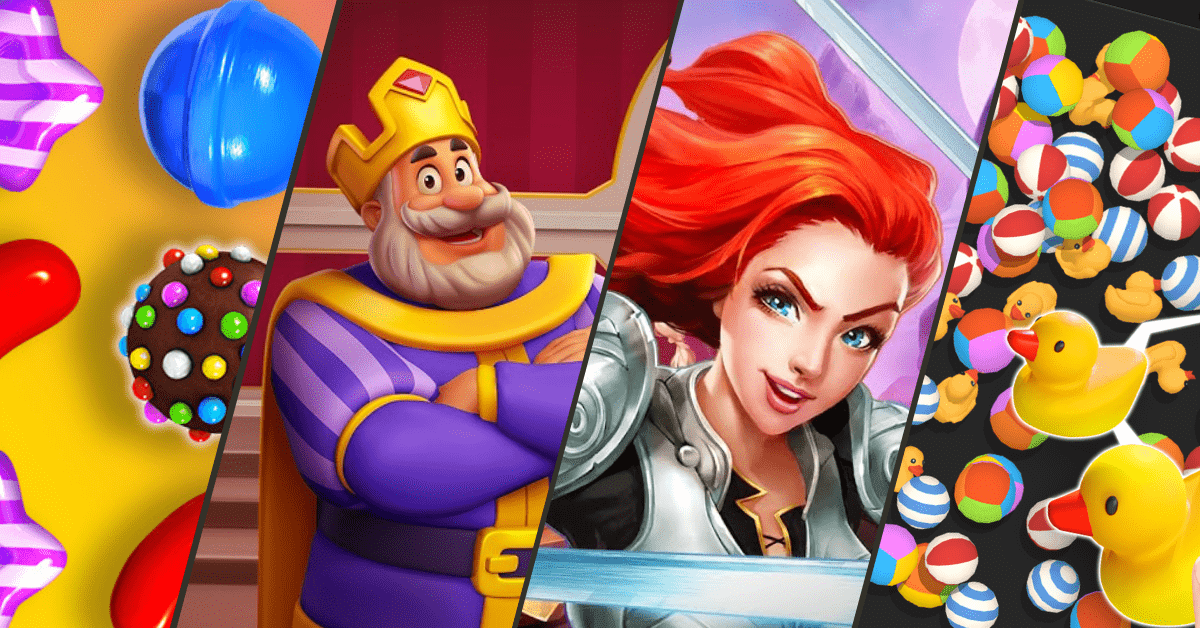In today’s mobile-centric world, puzzle mobile games are raking in significant revenue. They capture widespread engagement and set new standards for creativity. So what sets these top puzzle games apart?
If you’re a game developer or publisher looking to crack the code, buckle up. We’re diving deep into the mechanics, features, and strategies that have propelled certain puzzle games to the top of the charts.
Trust me, you’ll want to take notes.
Note: The following list of puzzle games includes the top-grossing puzzle games of 2023. Data source: AppMagic, a leading mobile intelligence provider. Get 3 days of free access to all AppMagic’s features and 10% off by clicking on this link.
1. Candy Crush Saga: The Sweet Spot of Addictive Gameplay
When it comes to mobile puzzle games, it’s hard to overlook Candy Crush Saga. Developed by King, this match-3 game has become synonymous with addictive gameplay. Not only that, it pioneered a revenue model that many have tried to emulate.
With its visually pleasing graphics, simple mechanics, and relentless pursuit of in-game rewards, Candy Crush Saga has many lessons for game creators.
Seamless Onboarding
One of the first things you notice about Candy Crush Saga is its smooth onboarding process.
As a developer, you should know that the first five minutes can make or break a player’s experience. Candy Crush Saga takes the player by the hand and walks them through the initial stages, blending tutorials seamlessly into gameplay.
Incremental Complexity
What keeps players coming back to Candy Crush Saga is the game’s uncanny ability to balance challenge and accessibility.
The game starts off simple enough to make players feel accomplished but gradually introduces more complex elements and challenges. As a result, players don’t feel overwhelmed, and there’s always a new hurdle to jump.
Consider adopting this approach to ensure long-term engagement for your game.
Reward Systems
Candy Crush Saga excels in its ability to reward players, whether it’s through unlocking new levels, granting special power-ups, or the much-celebrated cascade effects when you make a smart match.
A well-crafted reward system not only encourages continued play but can also be an excellent monetization strategy. It’s a win-win situation: players feel rewarded, and you see higher in-game purchases and retention rates.
Social Integration
Let’s face it, games are more fun with friends.
Candy Crush Saga leverages social integration for shared milestones, lives, and accomplishments, making the game not just a solo endeavor but a community experience.
If your game can benefit from this, don’t hesitate to include social features that enable shared experiences and even a bit of friendly competition.
Monetization
Candy Crush Saga is also a master class in monetization. Through a blend of in-app purchases and timed challenges that offer unique rewards, the game keeps players invested—emotionally and financially.
If you’re looking for a successful revenue model, study how Candy Crush Saga introduces its monetization elements without detracting from the core gameplay experience.

2. Royal Match: The Kingdom of Niche Appeal
Following in the footsteps of giants like Candy Crush Saga, Royal Match by Dream Games has carved out its own kingdom in the puzzle game market.
With its regal theme, match-three mechanics, and level-based challenges, Royal Match has not only captured the essence of what makes puzzle games addictive but has also incorporated elements that make it stand out in a crowded marketplace.
Here’s what makes Royal Match a royal success.
Unconventional Theme
One aspect where Royal Match distinguishes itself is in its theme.
By incorporating a royal aesthetic complete with castles, kings, and a storyline to boot, the game draws in a niche audience.
As a game developer, don’t underestimate the power of a compelling theme. It’s not just about the looks; it can be a powerful magnet for gamers who might otherwise overlook it as just another puzzle game.
Variety and Pacing
Royal Match is not just about match-3 gameplay. The game regularly introduces various mini-challenges and puzzles to break the monotony.
The lesson here is clear.
A constant infusion of new elements keeps players engaged and curious about what’s coming next. Pacing is essential, and the integration of different types of challenges can give your game a dynamic feel.
Focused Incentives
This game knows how to incentivize its players. Every action, from clearing levels to daily logins, yields some reward that enriches the gameplay experience.
It might be a power-up, an in-game currency, or an item that gives players an edge in their next challenge. Providing a focused set of incentives that align with your game’s mechanics can drastically improve player retention.
Content Roadmap
Royal Match regularly rolls out updates, which ensures that the gameplay remains fresh and engaging. Frequent updates indicate a robust content roadmap, something that’s vital if you aim to keep your players hooked for months or even years.
Crafting a long-term content strategy can be a great way to keep your audience invested.
Effective Use of In-Game Currency
Monetization in Royal Match is subtly yet effectively executed. The game employs a dual-currency system that balances in-game achievements with opportunities for in-app purchases.
If you’re planning a freemium model for your game, take note of how Royal Match creates a delicate balance, allowing players to enjoy the game without feeling cornered into making purchases, yet tempting enough to consider it.
Learn more about this game in my Royal Match dissection.

3. Gardenscapes: Cultivating a Rich User Experience
Gardenscapes by Playrix has become more than just a game. It’s a virtual world that successfully combines puzzle-solving with storytelling and simulation, all wrapped in an accessible casual experience.
At its core, Gardenscapes is a match-3 game, but it offers so much more by interweaving a narrative and virtual space that players can customize and call their own.
This multi-faceted approach has lessons to share for any developer eager to expand the boundaries of what puzzle games can offer.
Narrative-Driven Gameplay
Gardenscapes doesn’t merely offer a succession of puzzles; it ties them to an evolving storyline where restoring and decorating a garden are essential elements.
As you develop your game, consider the impact of a strong narrative. A story provides context, meaning, and emotional engagement that can turn a casual player into a devoted fan. It’s no wonder that interactive story games are so popular – players love narrative game experiences.
Multiple Layers of Engagement
The game incorporates various elements like puzzle-solving, virtual gardening, and character interactions to keep players continuously engaged.
Adding multiple layers of engagement to your game can enrich the user experience and increase session lengths. It’s like offering a full-course meal instead of just appetizers.
A Personal Touch
What Gardenscapes does exceptionally well is give players a sense of ownership. The garden becomes a personal space, which increases emotional investment.
If there’s a way to let players personalize their experience in your game, integrate it. Ownership elevates engagement, and higher engagement often leads to better monetization.
Visual and Audio Rewards
Gardenscapes uses stunning visuals and satisfying sound effects as rewards for puzzle completion, enhancing the tactile pleasure of gameplay. The lesson here is that aesthetic elements are more than just decoration; they’re part of the user experience and can serve as intrinsic rewards that make the game more enjoyable.
Adaptability
As the game has evolved, Gardenscapes has been keen to adapt. The game incorporated user feedback and new trends into its updates.
The willingness to adapt and evolve not only helps in retaining existing players but also in attracting new ones. A static game risks becoming stale, so always keep an eye on ways to refresh and revitalize your game’s experience.

4. Homescapes: Building a Home Away from Home
Also from the creative labs of Playrix, Homescapes presents another fine example of how to engage players on multiple levels.
While it shares DNA with its sibling Gardenscapes, Homescapes focuses on renovating a house instead of a garden. It connects the dots between interior design and puzzle-solving.
Seamless Narrative Integration
Much like Gardenscapes, Homescapes employs a story-driven approach. The narrative here is integral, pulling players into the lives of its characters while giving context to the puzzles.
If you’re looking to create more than just a “pick-up-and-play” experience, consider how a compelling narrative can create emotional hooks that deepen player engagement.
Room for Creativity
Homescapes excels in offering creative choices within the game’s renovation aspect. Players can select various styles and items, making the experience highly personalized.
Think about how you can introduce elements of choice and creativity in your game. Offering multiple pathways or customization options can significantly enhance the sense of player agency.
Progress Tracking and Milestones
Homescapes smartly breaks down renovation tasks and level challenges into bite-sized milestones.
These offer natural stopping points for players and create an ongoing sense of achievement. What’s more, they make a long journey feel more manageable and rewarding.
Multi-Tasking Gameplay
By combining home renovation tasks with puzzle-solving, Homescapes keeps the gameplay fresh and engaging. This helps to break up any potential monotony and keep players invested for longer periods.
Robust Community Features
Last, but not least, Homescapes has invested in building a strong community around the game.
Whether it’s the in-game events or the online forums and social media presence, the sense of community serves as social proof and also helps in retaining players.
If your game is a long-term venture, cultivating a strong, active community can pay significant dividends in both player engagement and monetization.

5. Fishdom: Dive Into a Unique Gameplay Ecosystem
Fishdom, yet another gem from the Playrix stable, is the fifth top-earning game of 2023 so far. Clearly, Playrix is doing something right.
It takes the match-three formula and plunges it underwater. Fishdom offers a unique blend of puzzle-solving combined with aquarium management. It invites players to not just match tiles, but also to decorate and maintain their own virtual fish tanks.
Theme Differentiation
The aquatic setting of Fishdom instantly sets it apart from other match-3 games. In a crowded genre, this kind of thematic differentiation can be a lifeline.
As you plan your game, consider how a unique theme could serve as a hook to attract a specific audience or simply offer a fresh take on familiar mechanics.
Symbiotic Gameplay Elements
Fishdom uses its aquarium management features to enrich the match-3 gameplay, and vice versa.
Players can earn items for their aquarium by completing puzzle levels, making each aspect of the game feel integral to the other.
When designing your game, think about how you can create a symbiotic relationship between different gameplay elements to enrich the overall experience.
A Dynamic Feedback Loop
Fishdom employs a dynamic feedback loop that keeps players engaged. Success in the puzzle levels translates into rewards for the aquarium, which in turn motivates the player to advance further in the puzzles.
This creates a loop of engagement that keeps players coming back.
Educational Tidbits
While not its primary focus, Fishdom also manages to educate players subtly about various fish species and aquatic decorations. Adding an educational angle, even if it’s secondary to the main gameplay, can make your title more appealing to a broader audience.
Non-Essential Purchases
Fishdom’s monetization strategies are player-friendly, offering in-app purchases that are beneficial but not necessary to progress. If you’re sketching out your game’s revenue model, a balanced approach that doesn’t alienate players can be crucial for long-term success.

6. Puzzle & Dragons: A Fusion of Genres and Cultures
From the Japanese game developer GungHo comes Puzzle & Dragons, a title that successfully mashes together puzzle gameplay with elements of dungeon crawling and monster collection.
This compelling mix has not only captivated audiences in its home country but has also garnered a global following. Its blend of match-three mechanics and more complex elements is a good example of how to diversify the standard puzzle game mold.
Blending Genres
The most striking feature of Puzzle & Dragons is its successful blend of casual and mid-core gaming genres. By combining puzzle elements with RPG and dungeon-crawling mechanics, the game attracts a broad range of players.
Cultural Sensibilities
Puzzle & Dragons has leveraged its Japanese origins, incorporating art styles and themes that are deeply rooted in its cultural context. This makes the game stand out in a sea of Western-dominated titles.
You can consider this when developing your game: How can you incorporate unique cultural or regional elements to give it a distinctive flavor?
Complex Progression System
The game includes an intricate progression system for leveling up and evolving both your player character and your collection of monsters.
This complexity caters to gamers looking for a deeper, more strategic experience.
Social and Competitive Elements
Puzzle & Dragons incorporates multiplayer dungeons and team battles, making it not just a solitary experience but a social and competitive one as well. This taps into players’ desires for social interaction and competition, potentially increasing retention rates.
Strategic Monetization
The game employs a gacha system, a popular monetization method in Japanese mobile games, where players can pay to receive random virtual items.
While this model has its critics, it has been extremely effective for Puzzle & Dragons as well as many other games.

7. Candy Crush Soda Saga: Iterative Success
From King, the creators of the iconic Candy Crush Saga, comes Candy Crush Soda Saga, a title that successfully builds on its predecessor’s legacy.
The developers introduced new gameplay elements and challenges to spice up the familiar match-three formula. The game serves as a prime example of how to iterate successfully on an already successful IP, and it has some nuggets of wisdom to offer. Learn more about this approach in my guide to IP-based games!
Building on Familiarity
Candy Crush Soda Saga takes the well-known mechanics from its predecessor and adds fresh elements like soda bottles and gummy bears. This strikes a balance between offering a familiar experience and providing new challenges.
If you’re considering a sequel or spin-off, ponder how you can innovate while still catering to the original fan base.
Varied Gameplay Mechanics
The game incorporates a range of new gameplay features, such as different board shapes and objectives, to keep players engaged. This variety prevents the gameplay from becoming stale and offers players new challenges to master.
Layered Difficulty Levels
Candy Crush Soda Saga expertly utilizes layered difficulty levels, where initial stages serve almost as a tutorial before gradually increasing in complexity. This can help both new and returning players ease into the game, reducing player churn due to early-stage frustration.
User-Generated Challenges
One novel feature is the ability for players to create their own levels, adding a layer of user-generated content that keeps the community engaged. If it fits your game model, consider allowing users to contribute content, which not only extends the game’s lifespan but also builds a more engaged community.
Data-Driven Improvements
King has a history of using player data to fine-tune its games continually. They analyze player behavior to understand which levels are too easy or too hard and then adjust accordingly.
The lesson here is clear: continually collect data and be willing to tweak your game to optimize the player experience.

8. Empires & Puzzles: Where Strategy Meets Match-3
Empires & Puzzles, developed by Small Giant Games, takes the match-3 puzzle genre to the next level by blending it with elements of role-playing and base-building games.
The title offers a complex, yet accessible, gameplay experience that has captivated a diverse player base. This game serves as a textbook example of how to seamlessly integrate multiple game mechanics without overwhelming the player.
Strategic Depth
Unlike many match-3 games that focus solely on casual puzzle-solving, Empires & Puzzles introduces a layer of strategic depth.
The choices players make in the base-building and role-playing segments have a direct impact on the capabilities in the puzzle levels.
Multi-Dimensional Progression
In Empires & Puzzles, progression isn’t linear.
Players are incentivized to advance not just in the puzzle stages but also in building their empires and developing their characters. This creates multiple paths for player engagement and progression.
For your game, consider how you can offer various avenues for advancement to keep players invested over the long term.
Mechanics That Work Together
The game’s mechanics work in harmony: each complements the others, creating a well-rounded gameplay experience.
For instance, completing puzzles earns resources that can be used in base-building and character development.
Social Elements and Collaboration
Empires & Puzzles incorporates multiplayer elements such as PvP battles and events. These social features add a layer of collaborative gameplay that enhances player engagement and retention.
Social components can be a valuable addition to your game, as they create a sense of community and provide new challenges and dynamics that single-player modes might not offer.
Flexibility in Monetization
The game’s monetization is flexible, allowing players to engage at different financial commitment levels.
Players can enjoy the game without spending money but have the option for quicker progression through in-app purchases. The game also utilizes in-game ads.
When planning your revenue model, consider how to make it as inclusive as possible, catering to both free players and those willing to invest money.

9. Toon Blast: Mastering Engagement
Toon Blast, developed by Peak Games, resists the trend of adding layers of complexity to the puzzle genre.
With its cartoonish graphics and easy-to-understand gameplay, Toon Blast has found a formula that’s as appealing to kids as it is to adults. For developers, the game offers essential takeaways on how simplicity, when executed correctly, can yield highly engaging experiences.
Focused Core Gameplay
Toon Blast puts all its eggs in one basket: core gameplay.
While there’s the addition of mini-games, the developers focused mostly on perfecting the tile blast gameplay. For your project, don’t underestimate the power of mastering the basics. Sometimes, that’s all you need to stand out in a market.
Intuitive Design
From the user interface to the in-game graphics, everything in Toon Blast is designed for clarity and ease of use. This intuitive design makes the game accessible to a wide range of players, from kids to adults.
While designing your game, remember that usability can be a significant differentiator. Make the game easy to understand, and you’ll widen your potential audience.
A Twist on Objectives
While the basic gameplay is simple, Toon Blast adds interest by frequently changing level objectives. One level might focus on collecting a specific type of block, while another might require players to clear the board in a certain number of moves.
These ever-changing goals keep players engaged without overwhelming them.
Community and Social Features
Toon Blast incorporates social elements by allowing players to join teams and participate in tournaments.
This sense of community can significantly increase player retention.
Balanced Monetization
Toon Blast’s monetization strategy walks the fine line between revenue generation and player satisfaction. Players can enjoy the game without feeling pressured to make purchases, but those who choose to spend money find value in their investment.
Another way Toon Blast players are monetized is through ads, creating a hybrid monetization strategy that seems to work extremely well.

10. Triple Match 3D: The Power of Novelty in Familiar Settings
In a crowded market of top puzzle games, Boombox Games’ Triple Match 3D carves out a distinct niche by injecting a 3D element into the classic match-3 formula.
While many other titles stick to a 2D grid, this game literally adds an extra dimension. It’s a good example of how small tweaks can make a big difference in player engagement and retention.
The 3D Factor
The standout feature in Triple Match 3D is, of course, its 3D gameplay. This simple change alters the dynamics of matching and strategy, offering a fresh experience even to those who have played countless 2D match-three games.
Spatial Awareness and Strategy
The 3D environment introduces a layer of spatial awareness that isn’t present in 2D match-three games.
Players must think in multiple dimensions, which adds depth to the gameplay without making it overly complex. When developing your game, consider how elements of spatial reasoning could make the experience more engaging without complicating the core mechanics.
Minimalist Design
Triple Match 3D adopts a minimalist aesthetic, which complements its 3D gameplay by making the screen less cluttered and easier to navigate.
This enables players to focus on the game mechanics themselves.
Satisfying Feedback Loops
The game includes feedback mechanisms like sounds and animations that are triggered by successful matches, which creates a rewarding experience for players.
These details may seem small, but they contribute significantly to player satisfaction and can encourage prolonged engagement.
Frequent Updates
One of the keys to Triple Match 3D’s ongoing success is its commitment to frequent updates, which keeps the gameplay fresh and engaging.
From new levels to gameplay tweaks, these updates give players a reason to return. For your title, a regular update schedule can help maintain interest and provide ongoing value to your player base.
Lessons from Top Puzzle Games: Final Thoughts
As diverse as these games are, they share common threads that contribute to their status as top puzzle games.
Whether it’s the innovative iteration on established IPs seen in Candy Crush Soda Saga, the genre-blending mechanics of Empires & Puzzles, the simplicity of Toon Blast, or the novel 3D gameplay in Triple Match 3D, each offers valuable lessons for developers.
The focus shouldn’t just be on what makes each game unique, but also on what they collectively exemplify: a commitment to player engagement, a keen understanding of their target audience, and a willingness to innovate within their respective frameworks.
These principles, whether applied in a straightforward or complex manner, can serve as a roadmap for developers and publishers looking to make their mark in this highly competitive space.







Comments